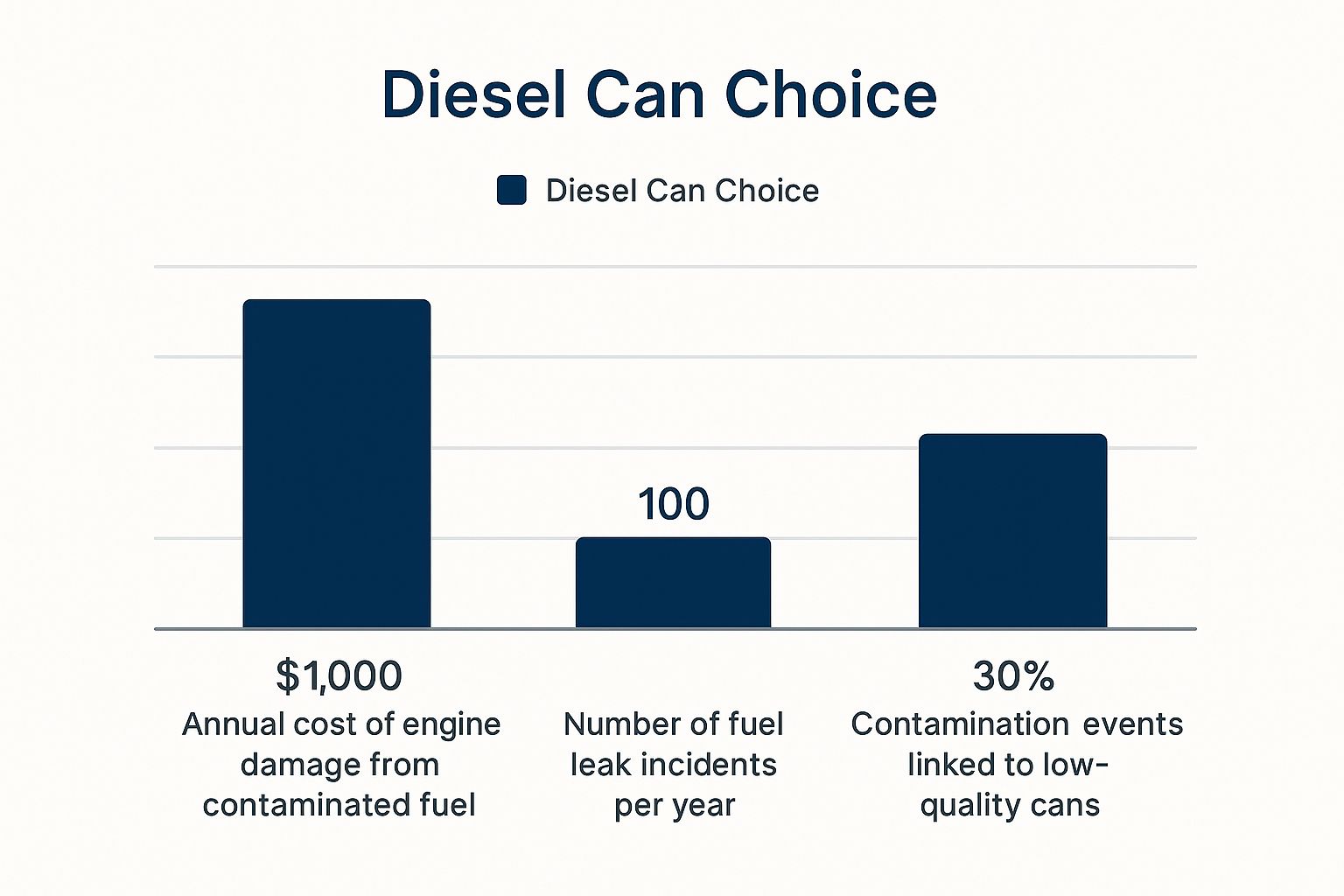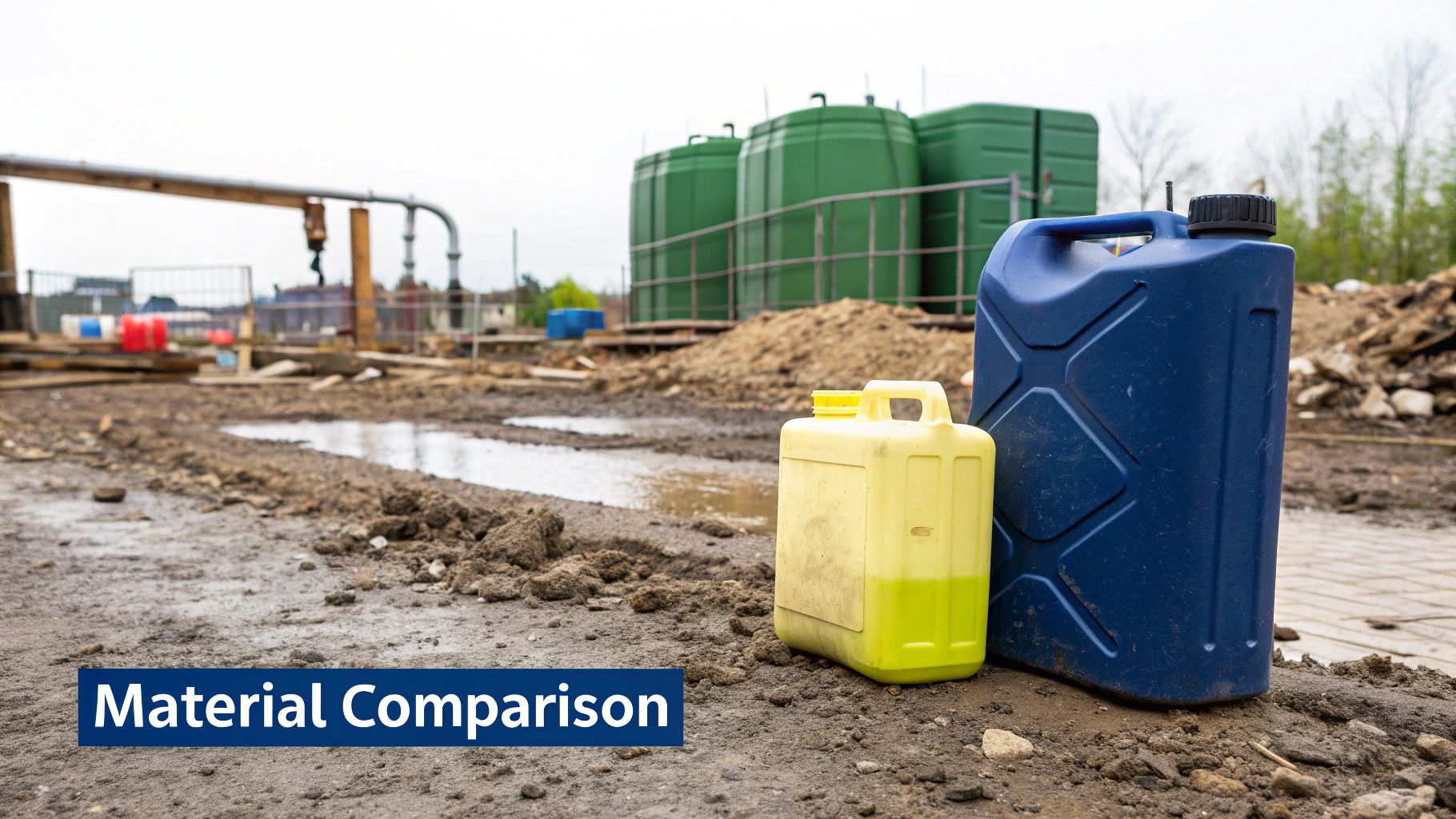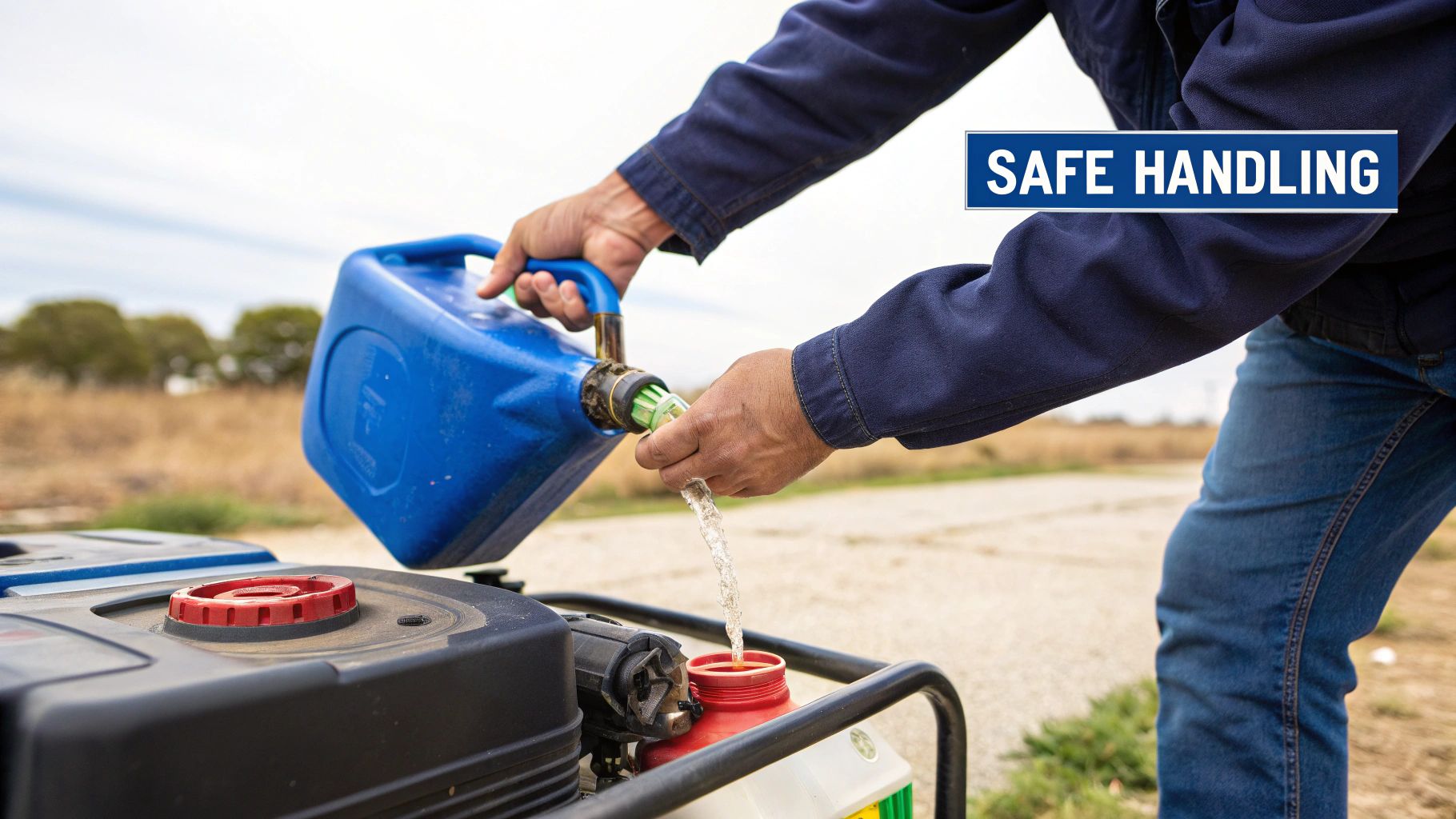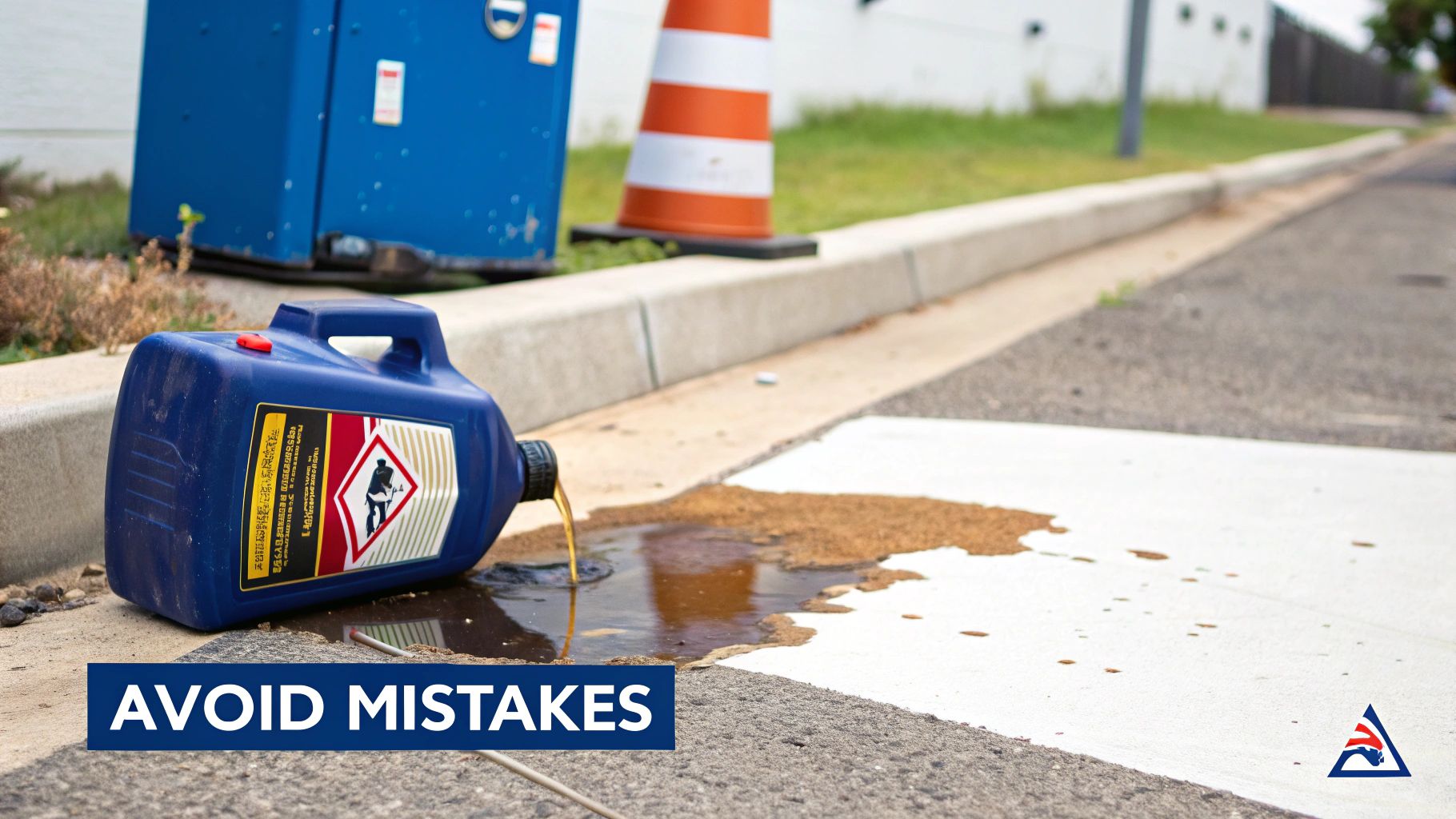A 10-gallon diesel can is more than just a plastic or metal box. It’s your first line of defense for keeping your fuel clean and your equipment running smoothly. Whether you're on a farm, a construction site, or just keeping a generator ready, picking the right can is a decision that pays off in the long run.
Why Your Diesel Can Choice Matters
Think of a 10-gallon diesel can as an investment, not just a purchase. A cheap, flimsy can might save you a few bucks today, but it can lead to serious headaches down the road. We’re talking about everything from fuel contamination wrecking a five-figure engine to a dangerous leak creating a serious fire hazard.
A good can keeps out the enemies of your engine: dirt, water, and debris. On the flip side, a poorly made container can actually add contaminants. Cheap plastic can degrade and flake, and a bad seal is an open invitation for moisture. In industries where every minute of downtime costs money, you can't afford to take that risk.
The Real-World Impact of Your Choice
The stakes are higher than you might think. What starts as a small fuel issue can quickly spiral into a major problem.
- Engine Damage: Dirty diesel is notorious for clogging fuel injectors and filters. This leads to rough performance, lost power, and eventually, a trip to the mechanic for an expensive overhaul.
- Safety Hazards: A faulty seal or a crack in a low-quality can is a spill waiting to happen. If a spill does occur, you need to act fast. For the right way to handle it, check out our guide on what to do: https://clixfueling.com/blogs/news/diesel-fuel-spill-cleanup-procedure
- Fuel Waste: A can that doesn't seal properly will let your fuel evaporate into thin air. Spills during transport are just as bad. Either way, you're literally watching your money disappear.
This infographic breaks down some of the annual costs and incidents tied directly to poor fuel storage.

As the numbers show, spending a little more on a quality can is a smart move to sidestep much bigger financial and safety risks.
The global diesel market was valued at a massive USD 237.72 billion in 2023 and is only getting bigger. This highlights just how many people rely on this fuel. For a look at the different types of fuel cans available in Australia, you can see the variety of options out there. With so much at stake, proper fuel management starts with a dependable 10 gallon diesel can.
Choosing Your Can: Materials and Safety Features

When you’re picking out a 10 gallon diesel can, the first fork in the road is deciding on the material. Your two main choices are high-density polyethylene (HDPE) plastic or the old-school, tried-and-true steel.
There’s no single right answer here. The best choice really depends on how you plan to use it. A plastic can might be perfect for tossing in the back of a truck for occasional use, while a steel can could be the only thing that survives daily life on a rugged job site.
Plastic vs. Metal: What's the Real Difference?
Let’s break down the pros and cons.
HDPE plastic cans are the go-to for many people because they're light, they won’t rust, and they’re usually easier on the wallet. They can also take a surprising amount of abuse—drop one, and it’s more likely to bounce than dent. The downside? If you leave it sitting out in the sun constantly, the UV rays can make the plastic brittle over time.
Steel cans are the heavyweights. They're incredibly tough and offer the best protection if you’re worried about punctures. But that durability comes with extra weight, and if you scratch the protective coating, rust can start to creep in. It’s a classic trade-off: portability versus raw strength.
Don't Skimp on Safety Features
The material is just the beginning. The real game-changers are the modern safety features built into today's cans. These aren't just bells and whistles; they are essential for preventing spills, controlling dangerous vapors, and keeping you safe.
- Flame Arrestors: This is a non-negotiable. It's a small screen inside the spout that stops an accidental spark or flame from igniting the fumes inside the can.
- Self-Venting Spouts: Diesel expands and contracts with temperature changes, building up pressure. A self-venting spout automatically lets this pressure escape, so the can doesn't swell up or leak.
- Leak-Proof Gaskets: A good, tight seal is everything. A quality gasket in the cap prevents messy fuel spills and stops flammable vapors from escaping.
To help you visualize what to look for, here's a quick comparison of how these materials and safety features stack up.
Diesel Can Material and Safety Feature Comparison
| Feature | HDPE (Plastic) | Steel (Metal) | Why It Matters |
|---|---|---|---|
| Durability | Resists dents, but can become brittle with UV exposure. | Puncture-resistant and very rugged. | Choose based on your work environment—a construction site needs more toughness than a garage. |
| Weight | Lightweight and easy to carry when full. | Significantly heavier, especially with 10 gallons of fuel. | Portability is key if you're moving cans around frequently by hand. |
| Corrosion | Completely rust-proof. | Can rust if the coating is scratched or damaged. | A major factor for longevity, especially in wet or humid climates. |
| Flame Arrestor | Essential | Essential | This is a critical safety feature that prevents external flames from igniting fuel vapors. |
| Self-Venting Spout | Essential | Essential | Prevents dangerous pressure buildup from temperature changes, stopping leaks and swelling. |
This table shows that while materials differ, the most important safety features are universal. Never buy a can without them.
The best 10 gallon diesel can is one that fits your daily grind and, most importantly, keeps safety at the forefront. If you find yourself refueling equipment often, you might even consider a diesel fuel can with a pump to make the job quicker and cleaner. By thinking through these details, you'll end up with a can that’s not just tough, but also safe and reliable for years.
Getting a Handle on Safe Transportation and Use

Having a solid 10 gallon diesel can is one thing, but knowing how to use it safely is what really matters. Getting the handling right prevents dangerous spills, stops you from wasting expensive fuel, and keeps both you and your equipment safe.
It all starts at the pump. I’ve seen it a hundred times: someone leaves their can in the truck bed while filling up. That’s a classic mistake that can lead to static electricity buildup—a serious fire hazard around fuel vapors. Always, always place the can flat on the ground before you start pumping.
This simple step grounds the container and gets rid of any static charge. Fill it slowly to prevent splashing, and never fill it to the very brim. You need to leave a little air gap at the top so the diesel has room to expand and contract as the temperature changes, which helps prevent leaks.
Securing Your Fuel for the Road
With the can full, your next job is to make sure it’s secure for the ride home. A full 10 gallon can of diesel weighs over 70 pounds. If that comes loose during a hard brake or a sharp turn, it becomes a dangerous projectile. The last place you want it is rolling around in your cab or trunk.
The best spot is in a truck bed or a well-ventilated cargo area. Tie it down tight with bungee cords or ratchet straps so it stays upright and can’t tip or slide. Good ventilation is also crucial, because even the best-sealed cans might let off a tiny bit of vapor.
Pro Tip: Try to keep your diesel can out of direct sunlight when you're driving. The heat can build up pressure inside the can, putting a strain on the seals and increasing the chance of a vapor leak.
Pouring Without the Mess
Trying to pour from a heavy, full 10 gallon diesel can can be a bit clumsy, but there’s a knack to it. Modern cans have spill-proof spouts, but they can be tricky. You usually have to press the spout firmly against the lip of the fuel tank to get the fuel flowing.
If you want total control and a guaranteed clean pour, a good funnel is your best friend. There are plenty of great fuel funnels for diesel designed specifically for the high flow from a big can. It’s a small investment that makes refueling machinery so much cleaner and safer.
Smart Storage and Maintenance Habits
A top-notch 10-gallon diesel can is built tough, but how long it lasts really comes down to how you treat it. A few simple habits can make all the difference, not just for the can itself but for the quality of the fuel inside. Taking care of your can means it'll be ready and reliable the moment you need it.
Where you keep your diesel can matters. A lot. The best spot is somewhere cool, dry, and well-ventilated—think a shed or a detached garage. The goal is to keep it out of direct sunlight and far away from any heat source or potential spark. Parking it next to your furnace or water heater is a recipe for trouble, as the heat can make the fuel expand and build up dangerous pressure inside the can.
Key Takeaway: Always store your diesel can in a stable, cool environment. Temperature extremes are the enemy of both the fuel and the container itself, leading to pressure buildup and potential degradation of the can's material over time.
Performing Regular Health Checks
Think of your 10-gallon diesel can like any other important tool in your garage—it needs a quick check-up now and then. Catching a small issue early can prevent a big headache, or even a serious safety hazard, down the road.
Here's what to look for:
- Check the Gasket: That little rubber ring inside the cap is crucial for a tight seal. Inspect it for any signs of cracking, brittleness, or warping. If it looks worn out, replace it.
- Inspect for Damage: Give the can itself a good once-over. On plastic cans, you're looking for cracks or any faded, discolored spots from sun exposure. For metal ones, keep an eye out for dents or any scratches that are starting to show rust.
- Keep It Clean: If you're putting the can away for a while, make sure it's completely empty. Let it air dry thoroughly before sealing it up. This simple step prevents moisture from getting trapped inside, which can lead to nasty microbial growth in any leftover fuel residue.
There's a reason quality storage is such a big deal. Containers in the 11 to 25 liters range, which includes the standard 10-gallon diesel can, actually dominate the market because they're used everywhere, from construction sites to personal workshops. This just goes to show how critical good, safe, leak-proof designs have become. You can learn more about the trends in the U.S. jerry can market to see why investing in quality pays off.
Common Mistakes to Avoid with Diesel Cans

Working with fuel seems simple enough, but a few common slip-ups can lead to everything from ruined equipment to serious safety hazards. I’ve seen them all over the years, and knowing what to watch out for is the best way to handle diesel safely and keep your machinery running smoothly.
The most common mistake? Overfilling. When you cram a 10 gallon diesel can full to the very brim, there's no space left for the fuel to expand. On a warm day, the pressure builds up and can force diesel right past the gasket or vent. You end up with a dangerous, slick mess. Just leave a little bit of air at the top—it makes all the difference.
Another classic blunder is letting diesel sit for too long without a stabilizer. Over time, diesel can fall victim to what we call "diesel bug," which is really just microbial growth that loves any trace of water. This creates a nasty sludge that will clog your fuel filters and can do real damage to your engine's injectors.
It's the Little Things That Get You
Beyond those two big ones, a few other details often get overlooked. They seem minor, but ignoring them can cause some major headaches down the road.
- Grabbing the Wrong Can: Never, ever use a red gasoline can for diesel. The color-coding is there for a reason: yellow is for diesel, red is for gasoline, and blue is for kerosene. A simple mix-up can absolutely destroy an engine.
- Skipping the Label: If you use different cans for different fuels, make them idiot-proof with clear labels. It takes five seconds and can prevent a very expensive repair bill.
- Ignoring a Bad Gasket: That little rubber seal in the cap is your first line of defense against leaks. Once it gets cracked, brittle, or worn out, it's useless. Get it replaced right away.
A Pro Tip From Experience: The gasket is almost always the first part to fail on any fuel can. A new one costs a few bucks, but letting a bad one go can lead to dangerous spills and you'll lose a surprising amount of fuel to evaporation.
Avoiding these simple mistakes with your 10 gallon diesel can is about more than just being careful. It’s about protecting your investment, keeping your equipment in top shape, and ensuring a safer environment for yourself and everyone around you.
Your Top Questions About Diesel Cans Answered
When you're dealing with something like a 10 gallon diesel can, a few questions always seem to pop up. Getting straight answers is key to handling your fuel safely and avoiding those small mistakes that can turn into big headaches.
So, how long should one of these cans actually last? With good care, a high-quality can—whether it's metal or plastic—should easily serve you well for 5-10 years. The real test isn't the calendar, though. If you spot any cracks, serious rust, or a gasket that’s seen better days, it's time to retire it. Safety first, always.
Common Problems and Simple Fixes
Let's talk about those "spill-proof" spouts. If you've ever struggled with one, you're not alone. The trick is to apply firm, even pressure against your tank's opening; this engages the internal spring and gets the fuel flowing. Still feel like you're wrestling with it? Just grab a good fuel funnel. It’s a cheap, easy solution that saves a lot of frustration.
Pro Tip: A stubborn spout is more than just an annoyance—it's a spill waiting to happen. If yours is worn out or just poorly designed, don't hesitate to replace it. A new spout is a small investment that makes a world of difference.
What about driving with a diesel can? Rules can change a bit from state to state, but the golden rule is universal: always secure the can upright in a ventilated space, like the bed of your truck. Never, ever transport it inside your car's passenger area. If you're using it for work, it's a good idea to double-check with your local transportation authority to make sure you're fully compliant with commercial regulations.
Tired of watching your fuel gauge like a hawk to prevent spills? For a truly hands-off and clean fueling process, especially on the water, take a look at CLiX Fueling Solutions. Our system is designed to automatically shut off the flow when the tank is full, preventing dangerous overflows for good. Find a smarter way to refuel.












